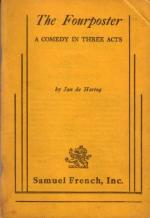|
This section contains 264 words (approx. 1 page at 400 words per page) |

|
The Fourposter Summary & Study Guide Description
The Fourposter Summary & Study Guide includes comprehensive information and analysis to help you understand the book. This study guide contains the following sections:
This detailed literature summary also contains Bibliography and a Free Quiz on The Fourposter by Jan de Hartog.
The Fourposter, Jan de Hartog's most successful play, was first produced at the Ethel Barrymore Theatre in 1951; it ran for 632 performances on Broadway. The play earned de Hartog the 1952 Antoinette Perry (Tony) Award. The Fourposter was adapted to the screen in a 1952 film produced by Columbia Pictures. A musical rendition, entitled I Do! I Do! opened on Broadway in 1966.
The Fourposter features two characters, Agnes and Michael, and spans the years 1890 to 1925, as key moments in their marriage are played out around their four-poster bed. In act 1, scene 1, they have just returned from their wedding ceremony, anxious and nervous about consummating their marriage. In scene 2, Agnes begins to feel the labor pains of their first child. In act 2, scene 1, Michael, who has become a highly successful writer, reveals to Agnes that he has been having an affair. In scene 2, Michael has just discovered what he thinks is a bottle of liquor in their son's bedroom. In act 3, scene 1, they have just returned from their daughter's wedding. In scene 2, they are moving out of their house to live in a smaller apartment.
De Hartog's play charts the ups and downs of a long-lasting marriage that is punctuated by moments of crisis and reconciliation. It maintains a balance in perspective between the special concerns and complaints of the woman and those of the man, as a function of their traditional societal roles. The "four-poster" bed, in and around which these moments of crisis are played out, symbolizes the lasting quality of the marriage bond, which remains steady throughout several decades of love and conflict.
Read more from the Study Guide
|
This section contains 264 words (approx. 1 page at 400 words per page) |

|



